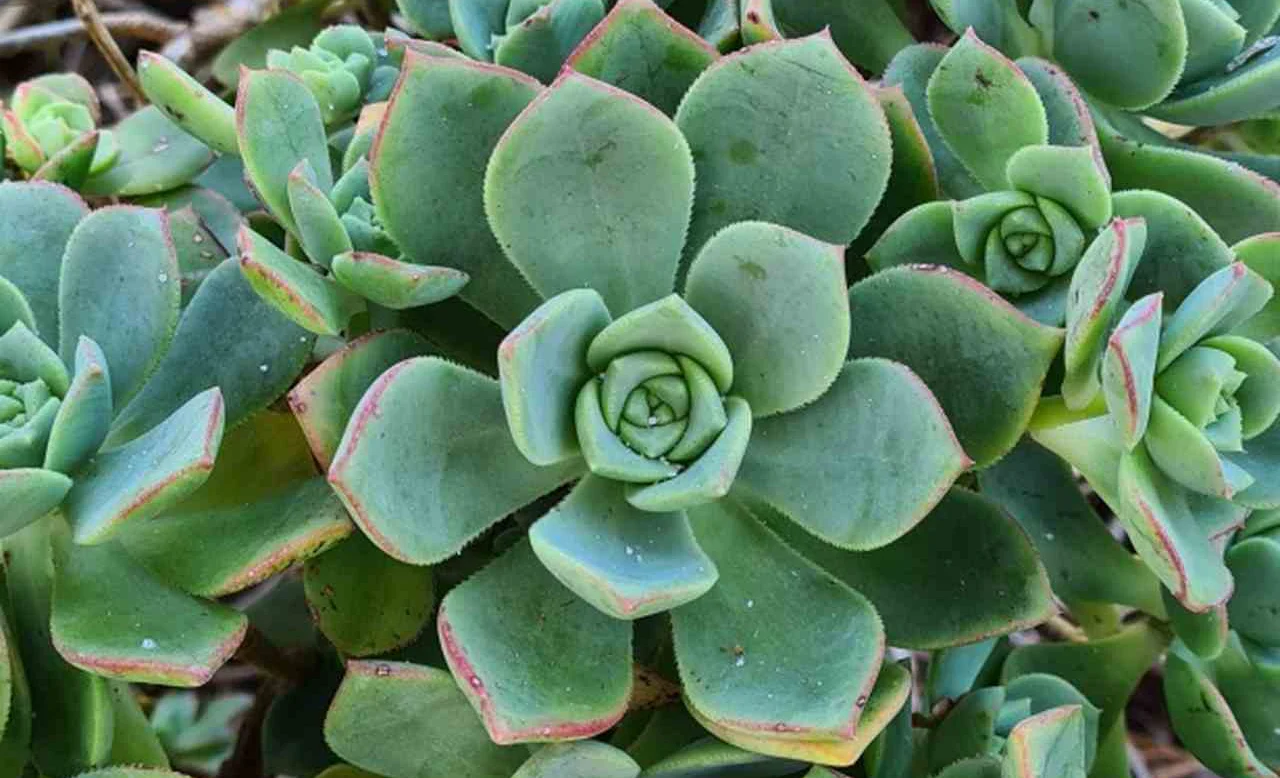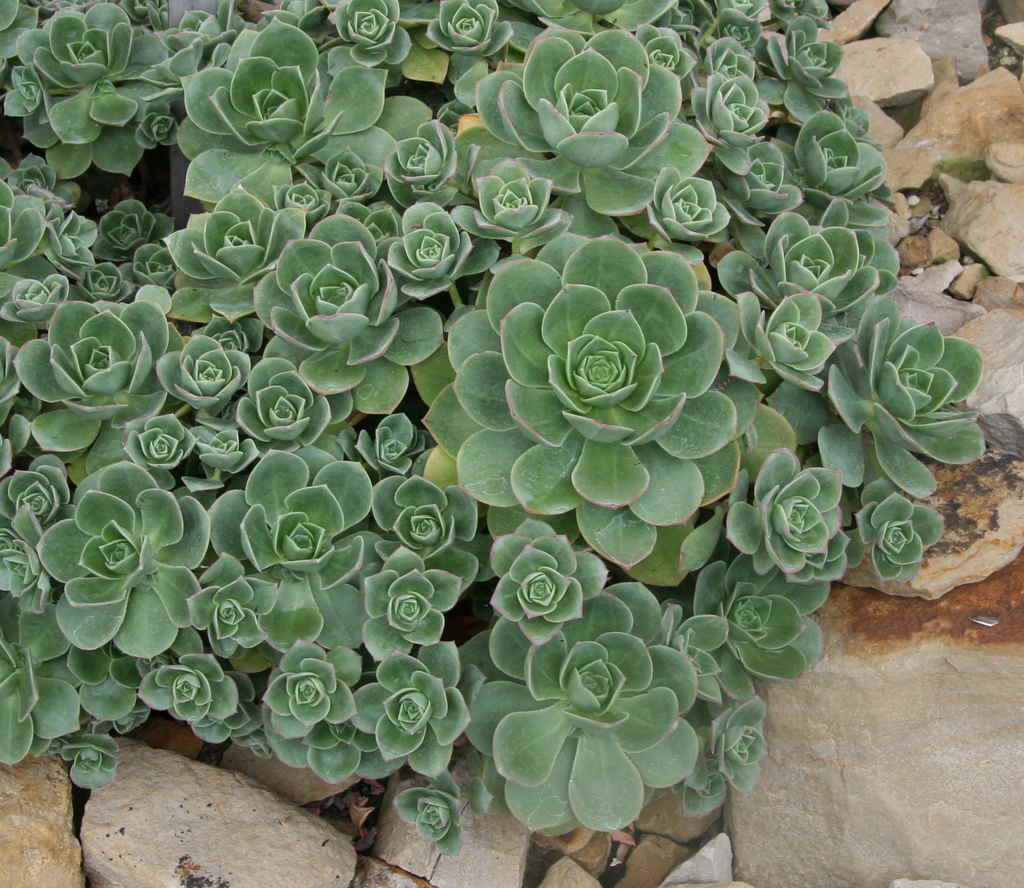How to Grow and Care For Aeonium PinWheels
The Aeonium Pinwheel is perhaps one of the most beloved succulents there is and it is not hard to see why! Boasting lush and intricate rosettes atop a study stem, this succulent can grow up to 2ft tall and tend to spread outwards rather than stay upright and straight.
Native to the sunny and volcanic climates of the Canary Islands and thriving in sandy and fertile soil, this super easy to care for plant will bring structure and the taste of paradise to your home all year round…what’s not to lava!
Botanical Name: | Aeonium haworthii |
|---|---|
Common Name(s): | Aeonium Pinwheel, Haworth's Aeonium |
Plant Type: | Succulent |
Place of Origin: | Canary Islands |
Sun Exposure: | Partial shade |
Watering Schedule: | Every 14 days |
Seasonality (best time to plant): | Late autumn through spring |
Bloom Time: | Spring |
Toxicity: | Safe for cats and dogs |

AEONIUM PINWHEEL WATER NEEDS
As with all succulents, the Aeonium Pinwheel likes to be soaked when watered, but doesn't like to sit in water or become waterlogged. We recommend watering when the top inch of soil becomes dry, which should be about every 2 weeks.
This may not seem like much, but the Aeonium Pinwheel stores water in its succulent leaves. In the summer, when the weather is hot, this plant does like to have a phase of partial dormancy, so keep the soil fairly dry to allow it to have a well deserved rest!
Rule of (Green) Thumb:Although this plant is very forgiving, many plants do not like to be watered with tap water. It is best to try and use water that is free from chlorine and chemicals. Filtered or rain water will be fine or if not possible use tap water that has been left overnight.
AEONIUM PINWHEEL LIGHTING NEEDS
Although hailing from the Canary Islands, the Aeonium haworthii is not a sun worshiper and will actually go into dormancy if it becomes too warm and sunny. With this in mind, it is best to position this plant in a partially shaded area where it will get 3-6 hours of direct sunlight.
An eastern facing window would be ideal for this succulent where it can bask in a little sun but be protected the rest of the day.
Rule of (Green) Thumb:If you bring your Aeonium pinwheel outdoors in summer, make sure you bring them back inside for the winter months.
AEONIUM PINWHEEL TEMPERATURE & HUMIDITY NEEDS
Although they are used to the warm temperatures of their native habitats in the Canary Islands and North Africa, Aeonium Pinwheels do not like to get too hot. Higher temperatures will cause them to conserve energy and go into dormancy.
An ideal temperature for the Pinwheel is around 50-75,℉ in a sheltered but bright spot where they do not risk sun damage. You will soon see that if they are too hot their leaves will begin to curl.
Pinwheels thrive in conditions that mimic their natural habitat, which is a more Mediterranean and temperate climate. Because they store a lot of water in their leaves, they don’t require humid conditions and prefer to be positioned in a dry spot.
If the conditions are too dry then the leaves will begin to look shriveled and prune-like, so you may need to increase the humidity.
AEONIUM PINWHEEL SOIL & FERTILIZER
Pinwheels like a mix of fertile loam and free draining sand to replicate their volcanic home. They will however be more than happy in a specialist succulent/cactus soil. The key is to ensure there is sufficient drainage to avoid root rot!
Fertilize once a month during fall and winter with a weak solution of fertilizer diluted down to half. In the summer they do not require fertilizer as they go into dormancy.
Nuture your plants and the planet with Rosy Soil!
AEONIUM PINWHEEL REPOTTING
Aeonium Pinwheels don’t need to be repotted too often - every 3 years should do it or before if showing signs.
Rule of (Green) Thumb:Don’t be too quick to repot plants, it can be super stressful for them so only do it when you are certain they would benefit from a change of scenery!

Aeonium Pinwheels are super easy to propagate and the easiest way is to take a cutting:
1. Take a long and healthy stem with a rosette on top of 10cm - 15cm in length and cut it off.
2. Leave the cutting to dry for a few days so that the cut heals or callouses over.
3. Take a pot of succulent/cactus compost and plant the cutting, water and leave somewhere where it won’t get too hot!
Rule of (Green) Thumb:Pinwheels are very easy to propagate so if you notice that yours is not doing so well just take a cutting and you will have a new plant in no time!
AEONIUM PINWHEEL COMMON PESTS & DISEASES
1. Root Rot - This is caused by overwatering. Signs of root rot include pale leaves and/or mushy stems. If the stem has gone mushy then it may be too late, but if just the leaves are affected then repot in free draining soil with gravel and water sparingly.
2. Mealy Bugs - Mealy bugs love the sweet sap of new growth and show up on Pinwheels as white tufts. They are greedy and can destroy a plant quickly, so make sure to clean the leaves and treat with an insecticide or neem oil.
3. Rosettes dying off - This usually happens after flowering and is totally normal - just cut the stem off at the base to divert the plant’s energy into making more stems and foliage.
AEONIUM PINWHEEL TOXICITY
Whilst some plants in the Aeonium genus are toxic, the Pinwheel is not, and is safe for your furry friends. However, as with all succulents and cacti, it is not recommended to eat them as a tasty snack, but feel safe in the knowledge that if it happens, it will cause no harm.
Top 10 Most Popular Roses
Mar 22, 2022
How to Care for China Roses
Mar 11, 2022
How to Care for Chinese Money Plants
May 15, 2020
How to Grow and Care for A Bird of Paradise
Apr 26, 2020
Top 10 Plants To Grow In A Terrarium
May 31, 2022
How to Grow and Care for Lucky Bamboo
Mar 29, 2022
How to Grow and Care for Corn Plants
Mar 29, 2022
How to Care for Madagascar Dragon Trees
Mar 21, 2022


